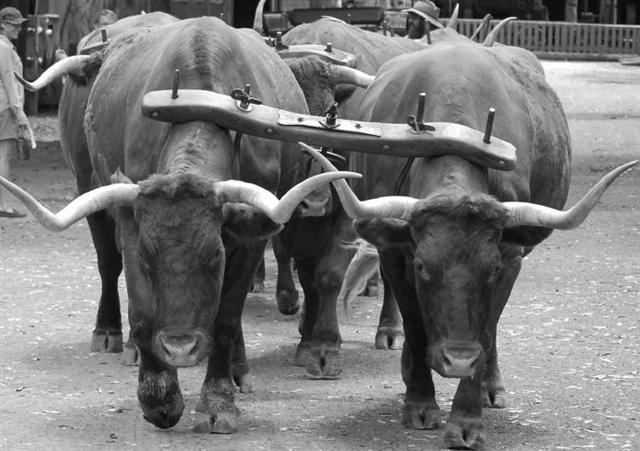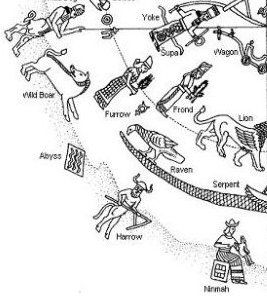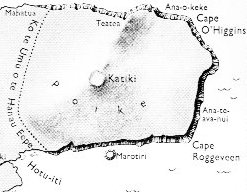Vaha kai in Gb5-10 could
visualize an ear, not only a
'seedling' (huri) but also the place where
the front side of a head is changing
into its back side. If so, then this
ear should belong to someone who is
looking back in time. 78 (MARCH 19)
- 16 = 62 (MARCH 3) and Beid (*62) is ο
Eridani ('the egg'):
 |
 |
 |
 |
12 |
|
Gb4-25 (345) |
Gb4-26 |
Gb4-27 (118) |
Gb4-28 (348) |
|
MARCH 1 |
2 |
3 (427) |
4 (63) |
|
Menkar
(44.7) |
3h (45.7) |
Misam (46.2),
Botein (46.9) |
ζ Arietis (47.7) |
|
Algol (45.9) |
|
May 4 |
5 (125) |
6 |
7 |
|
'April 7 |
8 (*18) |
9 (99) |
10 (465) |
|
"March 24 (448) |
25 |
26 (85) |
2-27 |
|
NAKSHATRA DATES: |
|
AUGUST 31 |
SEPTEMBER 1
(*164) |
2 |
3 |
|
Nadlat (227.8),
π Lupi (227.9) |
15h (228.3) |
ι Librae
(229.6), κ Lupi
(229.7), ζ Lupi
(229.8) |
Al
Zubānā-14b |
|
Zuben Hakrabim
(228.3), λ Lupi
(228.9) |
χ Bootis
(230.2), χ
Bootis (230.3),
Princeps
(230.6),
ZUBEN ELSCHEMALI
(230.8) |
|
November 3 |
4 |
5 |
6 (310) |
|
'October 7 (280) |
8 |
9 |
10 |
|
"September 23 |
24 |
25 (268) |
26 |
|
Egyptian eye |
 |
Phoenician
ayin |
 |
Greek omicron |
Ο (ο) |
|
... The letter
name is derived
from
Proto-Semitic
*‘ayn-,
eye, and the
Phoenician
letter had an
eye-shape,
ultimately
derived from the
jr
hieroglyph ...
To this day,
‘ayin
in Hebrew,
Arabic and
Maltese means
'eye' and
'spring' (‘ayno
in Neo-Aramaic). |
 |
 |
 |
|
 |
 |
| Gb5-8 |
Gb5-9 |
Gb5-10 |
Gb5-11 (135) |
Gb5-12 (365) |
| MARCH 17 |
18 |
19 (78) |
20 (444) |
0h |
| 4h (60.9) |
no star listed (61) |
Beid (62.2)
Vindemiatrix |
Al Dabarān-2 |
Hyadum II (64.2) |
| no star listed (60)
Cor Caroli |
HYADUM I (63.4) |
| May 20 |
21 |
22 (*427) |
23 |
24 (144) |
| 'April 23 (*33) |
24 |
25 (*400) |
26 (116) |
27 |
| "April 9 (99) |
10 (465) |
11 |
12 |
4-13 |
| NAKSHATRA DATES: |
| SEPTEMBER 16 |
17 (260) |
18 |
|
19 |
20 (*183) |
| 16h (243.5) |
ψ Scorpii (244.6), Lesath (244.8) |
χ Scorpii (245.1), Yed Prior, δ Tr. Austr. (245.5) |
Yed Posterior, Rukbalgethi Shemali (246.6). δ Apodis (246.7), ο Scorpii (246.8) |
Heart-5 |
| Acrab, Jabhat al Akrab (243.3), θ Lupi, Rutilicus (243.5), Marfik (243.7), φ Herculis (243.8) |
σ SCORPII (247.0), Hejian (247.2), ψ Ophiuchi (247.7) |
| November 19 |
20 |
21 (325) |
22 |
23 |
| 'October 23 (*216) |
24 |
25 |
26 |
27 (300) |
| "October 9 (*202) |
10 |
11 |
12 (285) |
13 |
|

If the mouth incised on the ao face can be relied upon, we can draw a conclusion:
| head in west (death) |
 |
 |
head in east (birth) |
| Gb5-10 |
*Yc1-3 |
The nose on the ao is above the V-formed upper lip. Therefore it should be at left in Gb5-10 and at right in *Yc1-3 ...
Vaha kai in *Yc1-3 is reversed compared to vaha kai in Gb5-10, and therefore also its meaning should be reversed. Its imagined head is pointing to the east, the direction of the rising sun. It ought to mean that sun is returning again, after having travelled under the earth from west to east during the 'night' ... |
In my preliminary glyph type dictionary I furthermore suggested Gb5-10 was at day 364 (= 4 * 91), having counted with 472 = 8 * 59 as the total round of days. 472 + 16 = 488 = 8 * 61. Gb5-12 could then be day 366 = 6 * 61. This means the rising
fish in Gb5-13 could represent the
1st day of the new cycle, equal to
day 1 beyond 0h at the time of the
Hyades Gate and also corresponding
to Ga1-1. Number 366 at Gb5-13 can
be understood as day 365 + 1.
 |
 |
 |
 |
| Gb5-13 (366) |
Gb5-14 |
Gb5-15 |
Gb5-16 (140) |
| MARCH 22 (*1) |
23 |
24 (448) |
25 (84) |
| Net-19 |
no star listed (66) |
no star listed (67) |
Rohini-4 / Pidnu-sha-Shame-5 / ANA-MURI |
| AIN, θ¹ Tauri, θ² Tauri (65.7) |
ALDEBARAN (68.2), Theemin (68.5) |
| May 25 (*430) |
26 |
27 |
28 (148) |
| 'April 28 (*403) |
29 |
30 (*40) |
'May 1 (121) |
| "April 14 |
15 (*390) |
16 (471) |
17 (107) |
| NAKSHATRA DATES: |
| SEPT 21 (264) |
EQUINOX |
23 (*186) |
24 |
| ρ Ophiuchi (248.1), Kajam (248.3), χ Ophiuchi (248.5), She Low, ι Tr. Austr. (248.7), ζ Tr. Austr. (248.8) |
Al Kalb-16 / Jyeshtha-18 / ANA-MUA |
γ Apodis (250.1), σ Herculis (250.3), θ Tr. Austr. (250.6), τ Scorpii (250.7) |
Han (251.0) |
| ANTARES (249.1), Marfik, φ Ophiuchi (249.5), ω Ophiuchi (249.8) |
| November 24 |
25 (329) |
26 |
27 |
| 'October 28 (301) |
29 (*222) |
30 |
31 |
| "October 14 |
15 (*208) |
16 |
17 (290) |
 |
 |
 |
 |
| Gb5-17 |
Gb5-18 |
Gb5-19 (372) |
Gb5-20 (144) |
| MARCH 26 (450) |
27 |
28 (*7) |
29 (88) |
| no star listed (69) |
no star listed (70) |
Tabit (71.7), π² Orionis (71.9) |
π4 Orionis (72.1), ο¹ Orionis (72.4), π5 Orionis (72.8) |
| May 29 |
30 |
31 (*436) |
June 1 (152) |
| 'May 2 |
3 |
4 (*44) |
5 (125) |
| "April 18 |
19 (*29) |
20 (475) |
21 (111) |
| NAKSHATRA DATES: |
| SEPTEMBER 25 |
26 |
27 (270) |
28 |
| ζ Herculis, η Tr. Austr. (252.1), η Herculis, β Apodis (252.5) |
Atria (253.9) |
Tail-6 |
ι Ophiuchi (255.3), Grafias (255.4) |
| Wei, η Arae (254.3), DENEBAKRAB (254.7) |
| November 28 |
29 (333) |
30 |
December 1 |
| 'November 1 |
2 |
3 (*227) |
4 (308) |
| "October 18 |
19 (292) |
20 |
21 (*214) |
The Babylonian 5th equinoctial Sun station 'Furrow of Heaven' (Pidnu-sha-Shame) could mean Land in the sky should be 'tilled' at Taurus:

The Furrow
in Virgo was somethinge else:

The Hanau Eepe
were ordered to work their
fields high up at Poike.
This seems to be an allusion to
what was due according to the
stars.

|
I
I.
1. Preposition denoting
the accusative: o te
hanau eepe i-hoa i te
pureva mai Poike ki tai,
the hanau eepe
threw the stones of
Poike into the sea.
Te rua muraki era i a
Hotu Matu'a. the
grave where they buried
Hotu Matu'a. 2.
Preposition: for,
because of, by action
of, for reason of...,
ku-rari-á te henua i te
ûa the ground is
soaked by the rain; i
te matu'a-ana te hakaúru
i te kai mo taana poki
huru hare, the
mother herself carries
(lit.: by the mother
herself the taking ...)
the food for her son
secluded in the house.
3. Preposition: in, on,
at (space): i te
kaiga nei, on this
island. 4. Preposition:
in, on (time): i
mu'a, before; i
agataiahi,
yesterday; i agapó,
tonight; i te
poá, in the morning.
5. Preposition: in the
power of: i a îa te
ao, the command was
in his power. 6. Adverb
of place: here. i au
nei, I am here
(also: i au i ,
here I am, here).
Vanaga.
Î.
Full; ku-î-á te kete
i te kumara, the bag
is full of sweet
potatoes. 2. To abound,
to be plentiful; ki î
te îka i uta, as
there are lots of fish
on the beach. 3. To
start crying (of a
baby): i-ûi-era te
ma-tu'a ku-î-á te poki
mo tagi, he-ma'u kihaho,
when a mother saw
that her baby was
starting to cry she
would take it outside.
Vanaga.
Toward; i muri oo na,
to accompany. Churchill.
Ii,
to deteriorate, to go
bad. Churchill. |
They began their
work by getting rid of all the
stones: o te
hanau eepe i-hoa i te
pureva mai Poike ki tai.
Perhaps it also meant they
intended to use the Sun for
measuring the months. The
increasing Sun light would make
star observations more difficult
than in winter.

|









